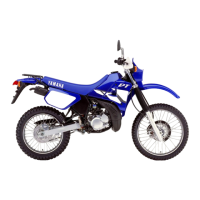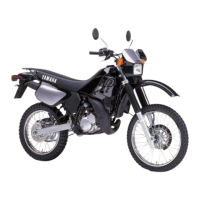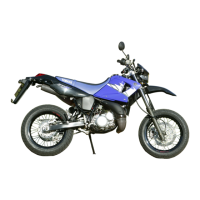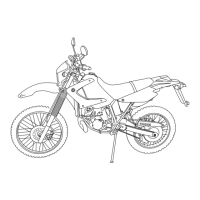Do you have a question about the Yamaha DT125X and is the answer not in the manual?
Guidelines for safe motorcycle operation, visibility, and awareness in traffic.
Ensures operator is qualified, within limits, and familiar with the motorcycle.
Details essential protective gear for motorcycle riders to prevent injuries.
Warns against unauthorized modifications that can affect safety and legality.
Advises on safe loading practices and accessory installation to maintain stability.
Covers safe practices for refueling and warnings about exhaust fumes.
Labels and describes components visible from the left side of the motorcycle.
Labels and describes components visible from the right side of the motorcycle.
Details the switches, levers, and instruments located on the handlebars.
Describes the functions of the main switch positions and how to lock steering.
Details the function of various indicator and warning lights on the dashboard.
Explains the speedometer, odometer, and tripmeter functions.
Details the operation of turn signal, dimmer, horn, and hazard switches.
Explains the function and operation of the clutch lever.
Describes how to use the shift pedal for gear changes.
Explains how to apply the front brake using the right handlebar lever.
Details how to apply the rear brake using the pedal on the right side.
Instructions on how to remove and install the fuel tank cap securely.
Covers safe fueling practices, fuel type, tank capacity, and reserve amount.
Information about the catalytic converter and exhaust system heat.
Specifies the type, quantity, and recommended oil for the 2-stroke engine.
Explains the function and different positions of the fuel cock.
Describes the starter lever's role in cold engine starting.
Instructions on how to remove and install the motorcycle seat.
Warns about handling the pressurized shock absorber and manufacturer's responsibility.
Advises on proper handling of the Yamaha Energy Induction System (YEIS).
Details the Yamaha Power Valve System (YPVS) and its adjustment.
Explains sidestand operation and warnings about riding with it down.
Describes the functions of the ignition circuit cut-off system and its components.
Provides a procedure to periodically check the operation of the ignition circuit cut-off system.
Lists essential items to check before each ride for safety and proper function.
Provides detailed checks for Fuel, Oils, Brakes, Clutch, and Throttle grip.
Lists checks for cables, chain, wheels, tires, pedals, levers, and electrical systems.
Detailed steps for starting the engine when it is cold, including safety checks.
Instructions for starting the motorcycle when the engine is already warm.
Explains how to use the transmission and shift gears effectively.
Crucial advice for the initial 1000 km to ensure engine longevity.
Specifies speed limits and operation advice during the engine break-in period.
Provides safety guidelines for parking the motorcycle, considering hot components.
Describes the tools provided and their intended use for maintenance.
Details maintenance tasks and intervals based on mileage and time.
Covers maintenance for tires, wheel bearings, swingarm, drive chain, chassis, sidestand, and fork.
Details maintenance for transmission oil, cooling system, brake switches, cables, and throttle grip.
Instructions for removing and installing various body panels for maintenance access.
Explains how to check the spark plug condition and specifications for replacement.
Details how to check the transmission oil level and procedure for changing the oil.
Explains how to check the coolant level and the coolant reservoir capacity.
Step-by-step guide on how to drain, flush, and refill the cooling system.
Instructions for cleaning the air filter element and check hose, and recommended oil.
Information on carburetor adjustment, recommending dealer service for complex tasks.
Procedure for checking and adjusting the engine's idle speed.
Details how to check and adjust the throttle cable free play at the grip.
Specifies tire pressure based on load and riding conditions, and loading warnings.
Instructions for tire inspection, minimum tread depth, and approved tire models.
Advice on inspecting spoke wheels, rims, and spokes for damage or looseness.
Procedure to adjust the clutch lever's free play for proper operation.
Detailed steps to adjust the clutch lever free play.
Procedure to adjust the front brake lever's free play and check brake system.
Instructions for adjusting the brake pedal's position and free play.
Details how to adjust the rear brake light switch for timely activation.
How to check brake pad wear and when to replace them.
Procedure to check brake fluid level and warnings about low levels.
Recommends dealer service for changing brake fluid and replacing seals/hoses.
Procedure to check the drive chain slack and position the motorcycle correctly.
Steps to adjust drive chain slack, ensuring proper wheel alignment.
Instructions for cleaning and lubricating the drive chain with special lubricants.
How to check and lubricate all control cables, and warnings about damage.
Procedure for checking and lubricating the throttle grip and cable.
How to check and lubricate the pivots of brake and clutch levers.
How to check and lubricate the sidestand pivot for smooth operation.
How to check the front fork's inner tubes for damage and its compression action.
Procedure to check for worn or loose steering bearings to ensure safe operation.
How to check front and rear wheel bearings for play or smooth turning.
Information on the sealed-type battery, its precautions, and charging.
Step-by-step guide to replacing a blown fuse with the correct amperage.
Instructions for replacing headlight bulbs, including safety warnings.
Procedure for replacing the tail and brake light bulbs.
Instructions for replacing turn signal light bulbs.
Methods for safely supporting the motorcycle when removing wheels or doing maintenance.
Steps to correctly install the front wheel, including speedometer gear unit.
Procedure for removing the rear wheel, including drive chain and axle nut.
Steps to correctly install the rear wheel, including drive chain and adjusting plates.
Provides a basic guide to checking vital systems and when to seek dealer service.
Diagnostic charts for fuel, compression, ignition, and battery issues.
Procedure for checking coolant levels and addressing engine overheating issues.
Steps to take before cleaning, like covering the muffler and checking caps.
Guides on cleaning methods, product usage, and avoiding damage to parts.
Instructions for cleaning the motorcycle after regular riding.
Specific steps to prevent corrosion after exposure to salt or wet roads.
Advice on storing the motorcycle in a cool, dry place and protecting it from dust.
Detailed steps for preparing the motorcycle for storage exceeding several months.
Instructions for battery storage, tire pressure, and final preparations before storage.
Lists overall dimensions, seat height, wheelbase, ground clearance, and weight.
Details engine type, displacement, cylinder arrangement, and oil requirements.
Information on frame type, caster angle, trail, and tire specifications.
Details the front brake type, operation, recommended fluid, and suspension type.
Details the rear brake type, operation, recommended fluid, and suspension type.
Lists the specifications for all bulbs used on the motorcycle, including indicators.
How to locate and record key and vehicle identification numbers for reference.
Details where the engine serial number is stamped on the crankcase.
Explains the location and importance of the model label for ordering parts.
Guidelines for safe motorcycle operation, visibility, and awareness in traffic.
Ensures operator is qualified, within limits, and familiar with the motorcycle.
Details essential protective gear for motorcycle riders to prevent injuries.
Warns against unauthorized modifications that can affect safety and legality.
Advises on safe loading practices and accessory installation to maintain stability.
Covers safe practices for refueling and warnings about exhaust fumes.
Labels and describes components visible from the left side of the motorcycle.
Labels and describes components visible from the right side of the motorcycle.
Details the switches, levers, and instruments located on the handlebars.
Describes the functions of the main switch positions and how to lock steering.
Details the function of various indicator and warning lights on the dashboard.
Explains the speedometer, odometer, and tripmeter functions.
Details the operation of turn signal, dimmer, horn, and hazard switches.
Explains the function and operation of the clutch lever.
Describes how to use the shift pedal for gear changes.
Explains how to apply the front brake using the right handlebar lever.
Details how to apply the rear brake using the pedal on the right side.
Instructions on how to remove and install the fuel tank cap securely.
Covers safe fueling practices, fuel type, tank capacity, and reserve amount.
Information about the catalytic converter and exhaust system heat.
Specifies the type, quantity, and recommended oil for the 2-stroke engine.
Explains the function and different positions of the fuel cock.
Describes the starter lever's role in cold engine starting.
Instructions on how to remove and install the motorcycle seat.
Warns about handling the pressurized shock absorber and manufacturer's responsibility.
Advises on proper handling of the Yamaha Energy Induction System (YEIS).
Details the Yamaha Power Valve System (YPVS) and its adjustment.
Explains sidestand operation and warnings about riding with it down.
Describes the functions of the ignition circuit cut-off system and its components.
Provides a procedure to periodically check the operation of the ignition circuit cut-off system.
Lists essential items to check before each ride for safety and proper function.
Provides detailed checks for Fuel, Oils, Brakes, Clutch, and Throttle grip.
Lists checks for cables, chain, wheels, tires, pedals, levers, and electrical systems.
Detailed steps for starting the engine when it is cold, including safety checks.
Instructions for starting the motorcycle when the engine is already warm.
Explains how to use the transmission and shift gears effectively.
Crucial advice for the initial 1000 km to ensure engine longevity.
Specifies speed limits and operation advice during the engine break-in period.
Provides safety guidelines for parking the motorcycle, considering hot components.
Describes the tools provided and their intended use for maintenance.
Details maintenance tasks and intervals based on mileage and time.
Covers maintenance for tires, wheel bearings, swingarm, drive chain, chassis, sidestand, and fork.
Details maintenance for transmission oil, cooling system, brake switches, cables, and throttle grip.
Instructions for removing and installing various body panels for maintenance access.
Explains how to check the spark plug condition and specifications for replacement.
Details how to check the transmission oil level and procedure for changing the oil.
Explains how to check the coolant level and the coolant reservoir capacity.
Step-by-step guide on how to drain, flush, and refill the cooling system.
Instructions for cleaning the air filter element and check hose, and recommended oil.
Information on carburetor adjustment, recommending dealer service for complex tasks.
Procedure for checking and adjusting the engine's idle speed.
Details how to check and adjust the throttle cable free play at the grip.
Specifies tire pressure based on load and riding conditions, and loading warnings.
Instructions for tire inspection, minimum tread depth, and approved tire models.
Advice on inspecting spoke wheels, rims, and spokes for damage or looseness.
Procedure to adjust the clutch lever's free play for proper operation.
Detailed steps to adjust the clutch lever free play.
Procedure to adjust the front brake lever's free play and check brake system.
Instructions for adjusting the brake pedal's position and free play.
Details how to adjust the rear brake light switch for timely activation.
How to check brake pad wear and when to replace them.
Procedure to check brake fluid level and warnings about low levels.
Recommends dealer service for changing brake fluid and replacing seals/hoses.
Procedure to check the drive chain slack and position the motorcycle correctly.
Steps to adjust drive chain slack, ensuring proper wheel alignment.
Instructions for cleaning and lubricating the drive chain with special lubricants.
How to check and lubricate all control cables, and warnings about damage.
Procedure for checking and lubricating the throttle grip and cable.
How to check and lubricate the pivots of brake and clutch levers.
How to check and lubricate the sidestand pivot for smooth operation.
How to check the front fork's inner tubes for damage and its compression action.
Procedure to check for worn or loose steering bearings to ensure safe operation.
How to check front and rear wheel bearings for play or smooth turning.
Information on the sealed-type battery, its precautions, and charging.
Step-by-step guide to replacing a blown fuse with the correct amperage.
Instructions for replacing headlight bulbs, including safety warnings.
Procedure for replacing the tail and brake light bulbs.
Instructions for replacing turn signal light bulbs.
Methods for safely supporting the motorcycle when removing wheels or doing maintenance.
Steps to correctly install the front wheel, including speedometer gear unit.
Procedure for removing the rear wheel, including drive chain and axle nut.
Steps to correctly install the rear wheel, including drive chain and adjusting plates.
Provides a basic guide to checking vital systems and when to seek dealer service.
Diagnostic charts for fuel, compression, ignition, and battery issues.
Procedure for checking coolant levels and addressing engine overheating issues.
Steps to take before cleaning, like covering the muffler and checking caps.
Guides on cleaning methods, product usage, and avoiding damage to parts.
Instructions for cleaning the motorcycle after regular riding.
Specific steps to prevent corrosion after exposure to salt or wet roads.
Advice on storing the motorcycle in a cool, dry place and protecting it from dust.
Detailed steps for preparing the motorcycle for storage exceeding several months.
Instructions for battery storage, tire pressure, and final preparations before storage.
Lists overall dimensions, seat height, wheelbase, ground clearance, and weight.
Details engine type, displacement, cylinder arrangement, and oil requirements.
Information on frame type, caster angle, trail, and tire specifications.
Details the front brake type, operation, recommended fluid, and suspension type.
Details the rear brake type, operation, recommended fluid, and suspension type.
Lists the specifications for all bulbs used on the motorcycle, including indicators.
How to locate and record key and vehicle identification numbers for reference.
Details where the engine serial number is stamped on the crankcase.
Explains the location and importance of the model label for ordering parts.
| Displacement | 124cc |
|---|---|
| Bore x Stroke | 56.0 mm x 50.7 mm |
| Fuel System | Carburetor |
| Ignition | CDI |
| Front Brake | Single disc |
| Front Tire | 110/70-17 |
| Final Drive | Chain |
| Engine Type | Liquid-cooled, 2-stroke, single-cylinder |
| Front Suspension | Telescopic fork |
| Rear Suspension | Swingarm |
| Rear Brake | Single disc |
| Starting System | Kick |
| Transmission | 6-speed |











